2008 INFINITI QX56 oil pressure
[x] Cancel search: oil pressurePage 3712 of 4083

SYSTEM SYMPTOMTM-165
< SYMPTOM DIAGNOSIS >
CEF
G H
I
J
K L
M A
B
TM
N
O P
36
Slips/Will
Not En-
gage With selector lever in
“R” position, accelera-
tion is extremely poor.
ON vehicle1. Fluid level and state
TM-178
2. Line pressure testTM-187
3. Accelerator pedal position sensor TM-69
4. High and low reverse clutch solenoid valve LAN-4
5. CAN communication lineLAN-4
6. Transmission range switchTM-43
7. Control cable adjustmentTM-194
8. Control valve with TCMTM-201
OFF vehicle9. Gear system
TM-22010. Output shaftTM-232
11. Reverse brakeTM-232
37While starting off by
accelerating in 1st, en-
gine races or slippage
occurs. ON vehicle
1. Fluid level and state
TM-178
2. Line pressure testTM-187
3. Accelerator pedal position sensor TM-69
4. CAN communication line LAN-4
5. Control valve with TCMTM-201
OFF vehicle6. Torque converter
TM-232
7. Oil pump assemblyTM-250
8. 3rd one-way clutchTM-252
9. 1st one-way clutchTM-259
10. Gear systemTM-220
11. Reverse brakeTM-232
12. Forward one- way clutch (Parts behind drum support is
impossible to perform inspection by disassembly. Refer to
TM-8
, TM-9
TM-232
13. Forward brake (Parts behind drum support is impossible
to perform inspection by disassembly. Refer to TM-8
, TM-9TM-232
38 While accelerating in
2nd, engine races or
slippage occurs. ON vehicle
1. Fluid level and state
TM-178
2. Line pressure testTM-187
3. Accelerator pedal position sensor TM-69
4. CAN communication line LAN-4
5. Direct clutch solenoid valveTM-84
6. Control valve with TCMTM-201
OFF vehicle7. Torque converter
TM-232
8. Oil pump assemblyTM-250
9. 3rd one-way clutchTM-252
10. Gear systemTM-220
11. Direct clutchTM-266
12. Forward brake (Parts behind drum support is impossible
to perform inspection by disassembly. Refer to TM-8
, TM-9TM-232
No. Items Symptom Condition Diagnostic ItemReference
page
Revision: March 2010 2008 QX56
Page 3713 of 4083

TM-166
< SYMPTOM DIAGNOSIS >
SYSTEM SYMPTOM
39Slips/Will
Not En-
gage While accelerating in
3rd, engine races or
slippage occurs.
ON vehicle
1. Fluid level and state
TM-178
2. Line pressure testTM-187
3. Accelerator pedal position sensor TM-69
4. CAN communication line LAN-4
5. High and low reverse clutch solenoid valveTM-86
6. Control valve with TCMTM-201
OFF vehicle7. Torque converter
TM-232
8. Oil pump assemblyTM-250
9. 3rd one-way clutchTM-252
10. Gear systemTM-220
11. High and low reverse clutchTM-264
12. Forward one- way clutch (Parts behind drum support is
impossible to perform inspection by disassembly. Refer to
TM-8
, TM-9
TM-232
13. Forward brake (Parts behind drum support is impossible
to perform inspection by disassembly. Refer to TM-8
, TM-9TM-232
40 While accelerating in
4th, engine races or
slippage occurs. ON vehicle
1. Fluid level and state
TM-178
2. Line pressure testTM-187
3. Accelerator pedal position sensor TM-69
4. CAN communication line LAN-4
5. Input clutch solenoid valveTM-80
6. Control valve with TCMTM-201
OFF vehicle7. Torque converter
TM-232
8. Oil pump assemblyTM-250
9. Input clutchTM-254
10. Gear systemTM-220
11. High and low reverse clutchTM-264
12. Direct clutchTM-266
No. ItemsSymptom Condition Diagnostic ItemReference
page
Revision: March 2010 2008 QX56
Page 3714 of 4083
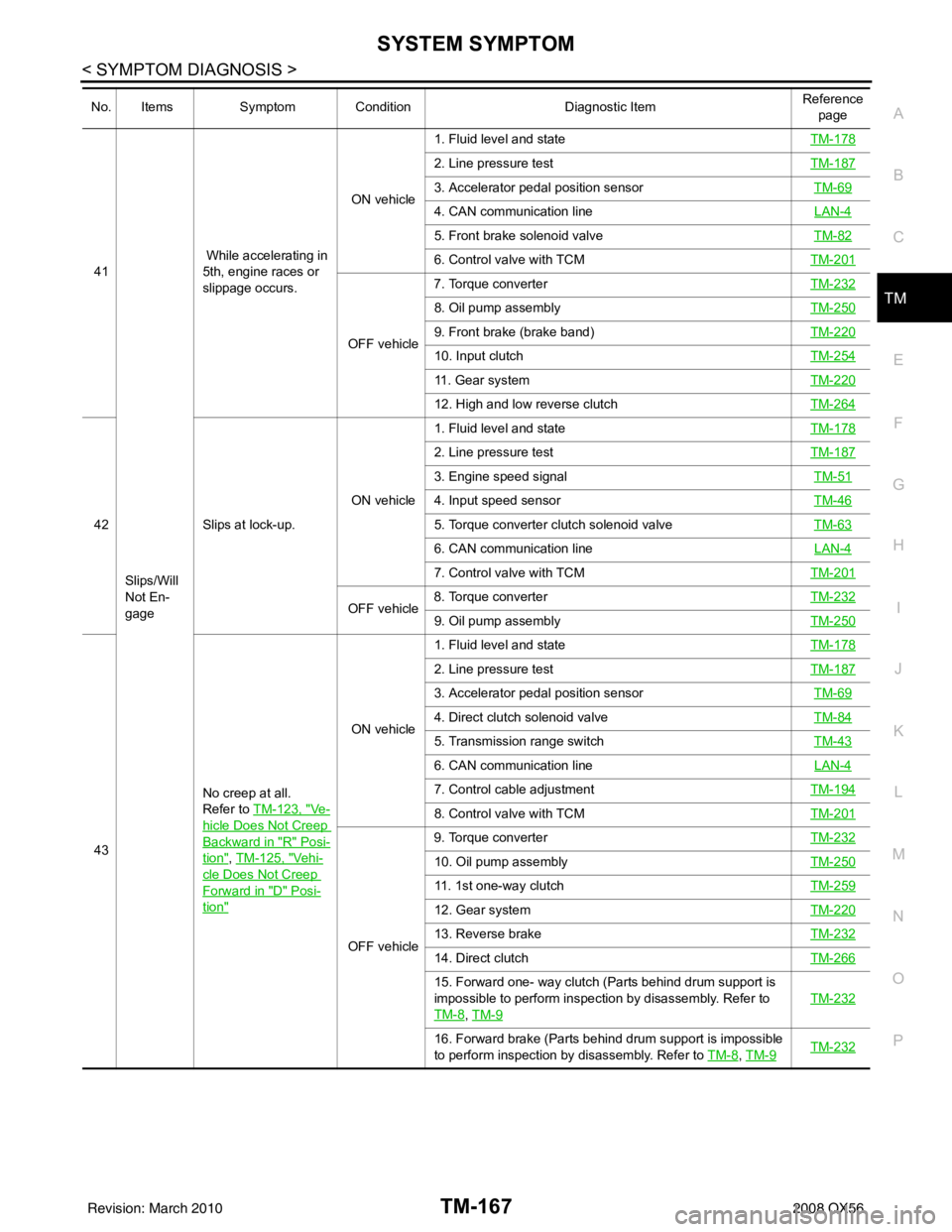
SYSTEM SYMPTOMTM-167
< SYMPTOM DIAGNOSIS >
CEF
G H
I
J
K L
M A
B
TM
N
O P
41
Slips/Will
Not En-
gage While accelerating in
5th, engine races or
slippage occurs.
ON vehicle
1. Fluid level and state
TM-178
2. Line pressure testTM-187
3. Accelerator pedal position sensor TM-69
4. CAN communication line LAN-4
5. Front brake solenoid valveTM-82
6. Control valve with TCMTM-201
OFF vehicle7. Torque converter
TM-232
8. Oil pump assemblyTM-250
9. Front brake (brake band)TM-220
10. Input clutchTM-254
11. Gear systemTM-220
12. High and low reverse clutchTM-264
42Slips at lock-up. ON vehicle1. Fluid level and state
TM-178
2. Line pressure testTM-187
3. Engine speed signal TM-51
4. Input speed sensorTM-46
5. Torque converter clutch solenoid valveTM-63
6. CAN communication line LAN-4
7. Control valve with TCMTM-201
OFF vehicle8. Torque converter
TM-2329. Oil pump assemblyTM-250
43No creep at all.
Refer to
TM-123, "
Ve-
hicle Does Not Creep
Backward in "R" Posi-
tion", TM-125, "Veh i-
cle Does Not Creep
Forward in "D" Posi-
tion"
ON vehicle 1. Fluid level and state
TM-178
2. Line pressure testTM-187
3. Accelerator pedal position sensor TM-69
4. Direct clutch solenoid valveTM-84
5. Transmission range switchTM-43
6. CAN communication line LAN-4
7. Control cable adjustmentTM-194
8. Control valve with TCMTM-201
OFF vehicle9. Torque converter
TM-232
10. Oil pump assemblyTM-250
11. 1st one-way clutchTM-259
12. Gear systemTM-220
13. Reverse brakeTM-232
14. Direct clutchTM-266
15. Forward one- way clutch (Parts behind drum support is
impossible to perform inspection by disassembly. Refer to
TM-8
, TM-9
TM-232
16. Forward brake (Parts behind drum support is impossible
to perform inspection by disassembly. Refer to TM-8
, TM-9TM-232
No. Items Symptom Condition Diagnostic ItemReference
page
Revision: March 2010 2008 QX56
Page 3715 of 4083
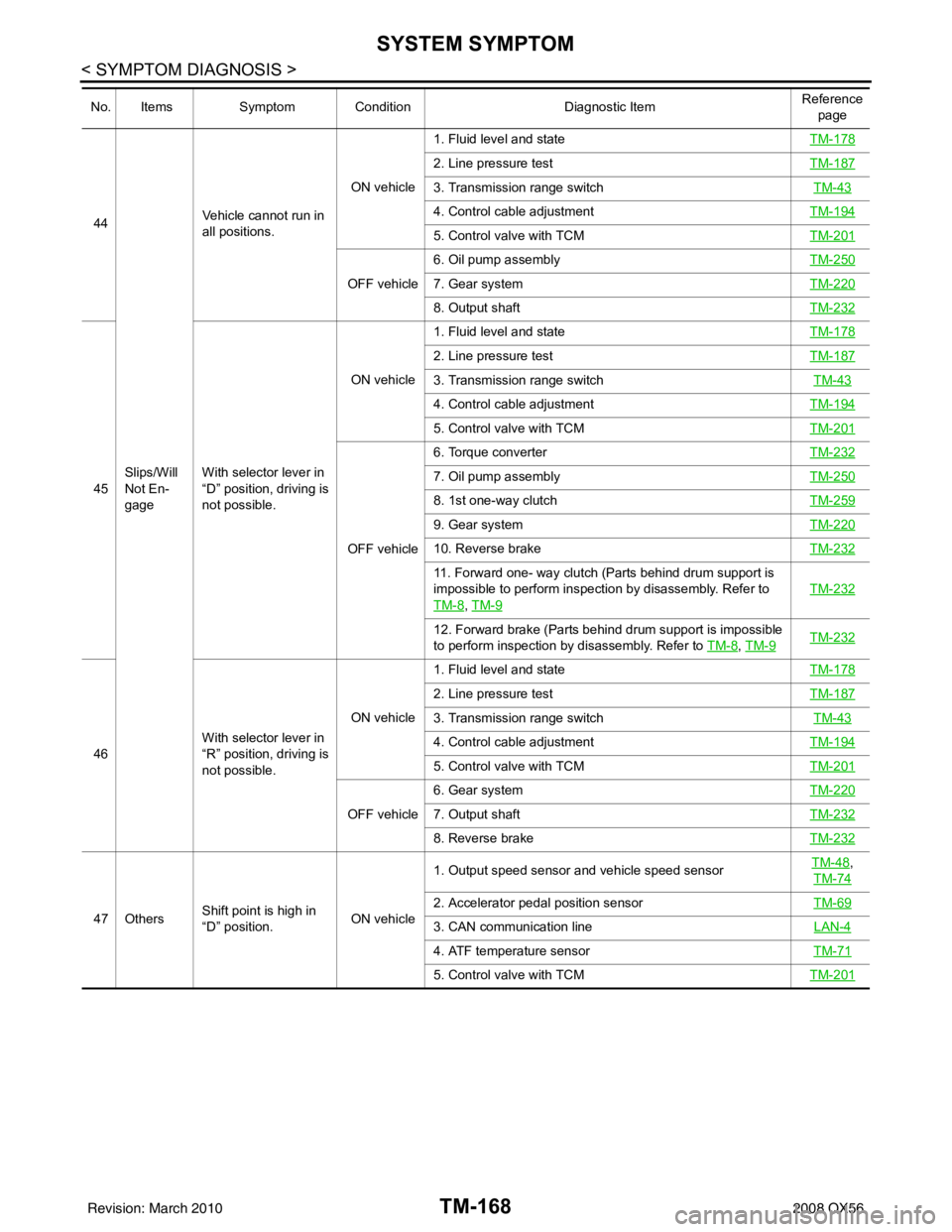
TM-168
< SYMPTOM DIAGNOSIS >
SYSTEM SYMPTOM
44Slips/Will
Not En-
gage Vehicle cannot run in
all positions.
ON vehicle1. Fluid level and state
TM-178
2. Line pressure testTM-187
3. Transmission range switch TM-43
4. Control cable adjustmentTM-194
5. Control valve with TCMTM-201
OFF vehicle6. Oil pump assembly
TM-2507. Gear systemTM-220
8. Output shaftTM-232
45With selector lever in
“D” position, driving is
not possible. ON vehicle
1. Fluid level and state
TM-178
2. Line pressure testTM-187
3. Transmission range switch TM-43
4. Control cable adjustmentTM-194
5. Control valve with TCMTM-201
OFF vehicle6. Torque converter
TM-232
7. Oil pump assembly TM-250
8. 1st one-way clutchTM-259
9. Gear systemTM-220
10. Reverse brakeTM-232
11. Forward one- way clutch (Parts behind drum support is
impossible to perform inspection by disassembly. Refer to
TM-8
, TM-9
TM-232
12. Forward brake (Parts behind drum support is impossible
to perform inspection by disassembly. Refer to TM-8
, TM-9TM-232
46 With selector lever in
“R” position, driving is
not possible. ON vehicle
1. Fluid level and state
TM-178
2. Line pressure testTM-187
3. Transmission range switch TM-43
4. Control cable adjustmentTM-194
5. Control valve with TCMTM-201
OFF vehicle6. Gear system
TM-2207. Output shaftTM-232
8. Reverse brakeTM-232
47 OthersShift point is high in
“D” position. ON vehicle1. Output speed sensor and vehicle speed sensor
TM-48
,
TM-74
2. Accelerator pedal position sensor TM-69
3. CAN communication line LAN-4
4. ATF temperature sensorTM-71
5. Control valve with TCMTM-201
No. ItemsSymptom Condition Diagnostic ItemReference
page
Revision: March 2010 2008 QX56
Page 3718 of 4083
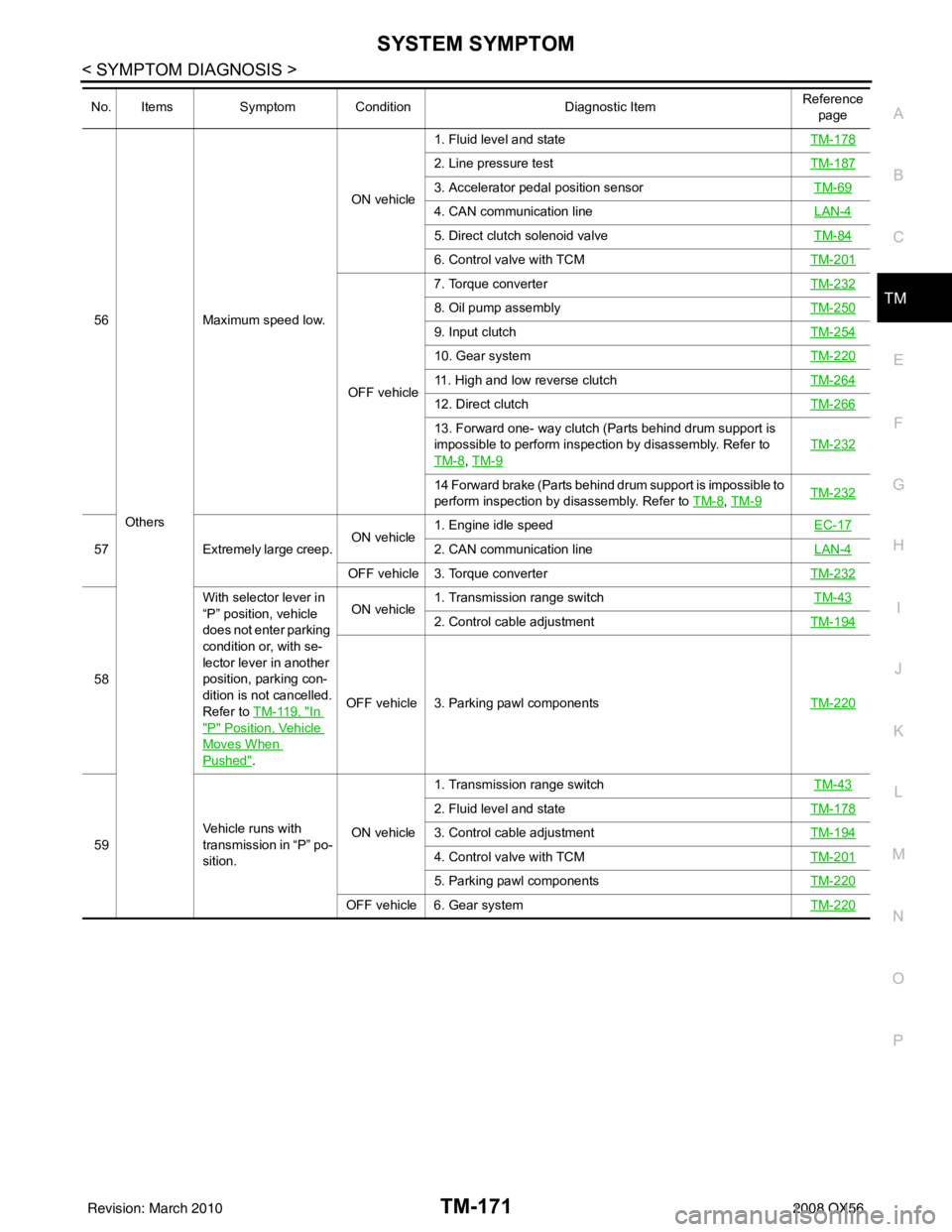
SYSTEM SYMPTOMTM-171
< SYMPTOM DIAGNOSIS >
CEF
G H
I
J
K L
M A
B
TM
N
O P
56
Others Maximum speed low.
ON vehicle
1. Fluid level and state
TM-178
2. Line pressure testTM-187
3. Accelerator pedal position sensor TM-69
4. CAN communication line LAN-4
5. Direct clutch solenoid valveTM-84
6. Control valve with TCMTM-201
OFF vehicle7. Torque converter
TM-232
8. Oil pump assemblyTM-250
9. Input clutchTM-254
10. Gear systemTM-220
11. High and low reverse clutchTM-264
12. Direct clutchTM-266
13. Forward one- way clutch (Parts behind drum support is
impossible to perform inspection by disassembly. Refer to
TM-8
, TM-9
TM-232
14 Forward brake (Parts behind drum support is impossible to
perform inspection by disassembly. Refer to TM-8
, TM-9TM-232
57 Extremely large creep. ON vehicle1. Engine idle speed
EC-172. CAN communication lineLAN-4
OFF vehicle 3. Torque converter TM-232
58With selector lever in
“P” position, vehicle
does not enter parking
condition or, with se-
lector lever in another
position, parking con-
dition is not cancelled.
Refer to
TM-119, "
In
"P" Position, Vehicle
Moves When
Pushed". ON vehicle
1. Transmission range switch
TM-43
2. Control cable adjustmentTM-194
OFF vehicle 3. Parking pawl components TM-220
59Vehicle runs with
transmission in “P” po-
sition. ON vehicle1. Transmission range switch
TM-43
2. Fluid level and stateTM-178
3. Control cable adjustmentTM-194
4. Control valve with TCMTM-201
5. Parking pawl componentsTM-220
OFF vehicle 6. Gear system TM-220
No. ItemsSymptom Condition Diagnostic ItemReference
page
Revision: March 2010 2008 QX56
Page 3723 of 4083
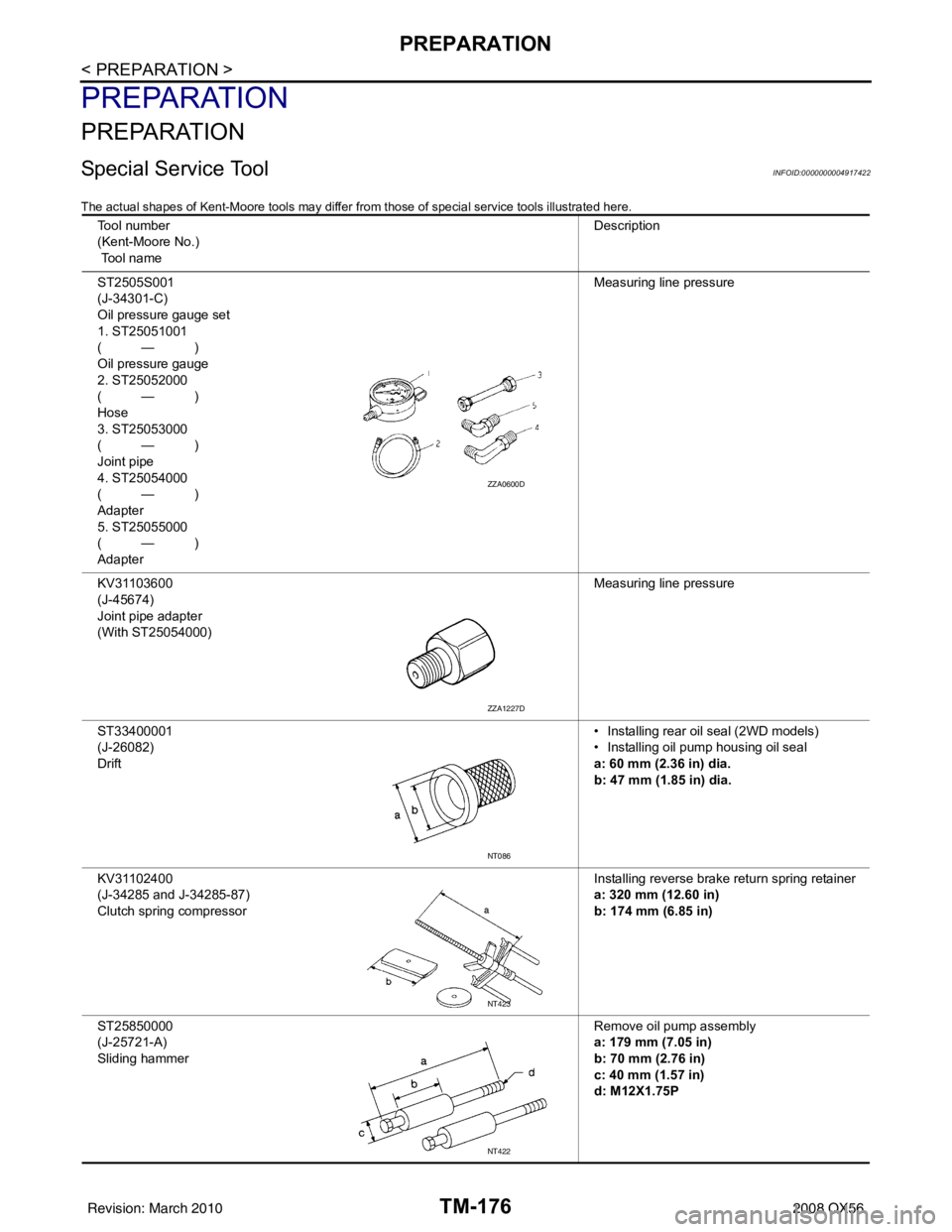
TM-176
< PREPARATION >
PREPARATION
PREPARATION
PREPARATION
Special Service ToolINFOID:0000000004917422
The actual shapes of Kent-Moore tools may differ from those of special service tools illustrated here.
Tool number
(Kent-Moore No.)
Tool name Description
ST2505S001
(J-34301-C)
Oil pressure gauge set
1. ST25051001
(—)
Oil pressure gauge
2. ST25052000
(—)
Hose
3. ST25053000
(—)
Joint pipe
4. ST25054000
(—)
Adapter
5. ST25055000
(—)
Adapter Measuring line pressure
KV31103600
(J-45674)
Joint pipe adapter
(With ST25054000) Measuring line pressure
ST33400001
(J-26082)
Drift • Installing rear oil seal (2WD models)
• Installing oil pump housing oil seal
a: 60 mm (2.36 in) dia.
b: 47 mm (1.85 in) dia.
KV31102400
(J-34285 and J-34285-87)
Clutch spring compressor Installing reverse brake return spring retainer
a: 320 mm (12.60 in)
b: 174 mm (6.85 in)
ST25850000
(J-25721-A)
Sliding hammer Remove oil pump assembly
a: 179 mm (7.05 in)
b: 70 mm (2.76 in)
c: 40 mm (1.57 in)
d: M12X1.75P
ZZA0600D
ZZA1227D
NT086
NT423
NT422
Revision: March 2010
2008 QX56
Page 3734 of 4083
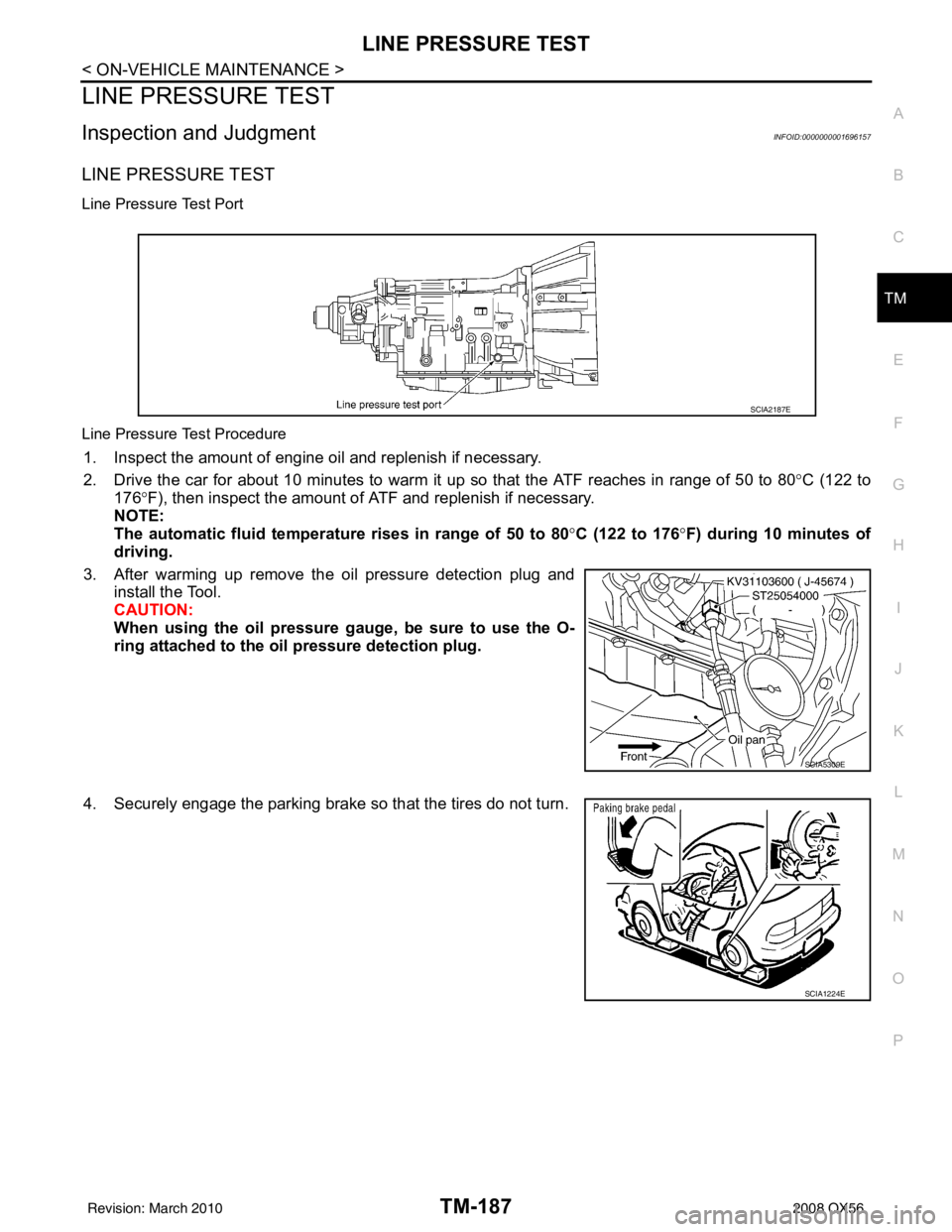
LINE PRESSURE TESTTM-187
< ON-VEHICLE MAINTENANCE >
CEF
G H
I
J
K L
M A
B
TM
N
O P
LINE PRESSURE TEST
Inspection and JudgmentINFOID:0000000001696157
LINE PRESSURE TEST
Line Pressure Test Port
Line Pressure Test Procedure
1. Inspect the amount of engine oil and replenish if necessary.
2. Drive the car for about 10 minutes to warm it up so that the ATF reaches in range of 50 to 80 °C (122 to
176° F), then inspect the amount of ATF and replenish if necessary.
NOTE:
The automatic fluid temperature rises in range of 50 to 80 °C (122 to 176° F) during 10 minutes of
driving.
3. After warming up remove the oil pressure detection plug and install the Tool.
CAUTION:
When using the oil pressure ga uge, be sure to use the O-
ring attached to the oil pressure detection plug.
4. Securely engage the parking brake so that the tires do not turn.
SCIA2187E
SCIA5309E
SCIA1224E
Revision: March 2010 2008 QX56
Page 3735 of 4083
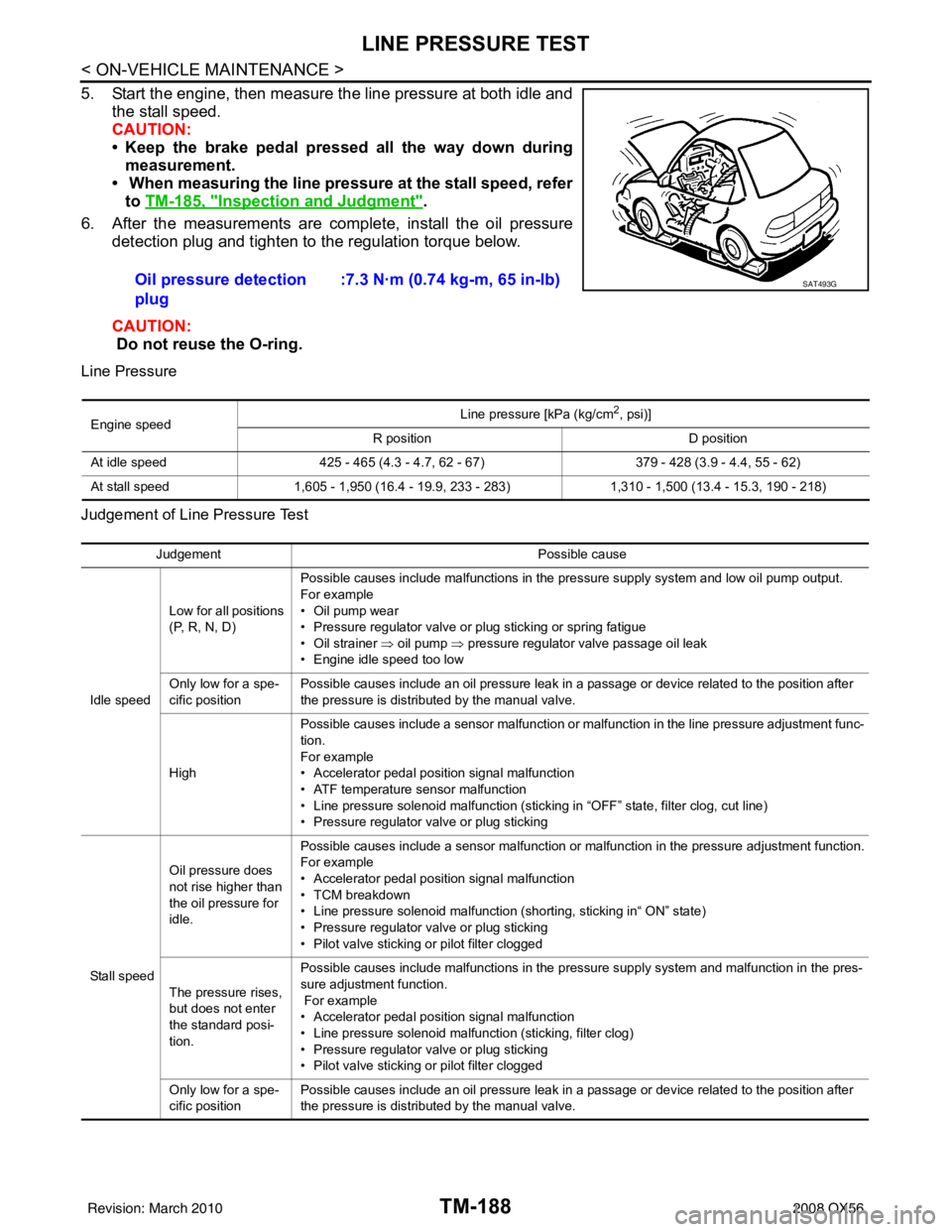
TM-188
< ON-VEHICLE MAINTENANCE >
LINE PRESSURE TEST
5. Start the engine, then measure the line pressure at both idle andthe stall speed.
CAUTION:
• Keep the brake pedal pressed all the way down duringmeasurement.
• When measuring the line pressure at the stall speed, refer
to TM-185, "
Inspection and Judgment".
6. After the measurements are complete, install the oil pressure detection plug and tighten to the regulation torque below.
CAUTION:
Do not reuse the O-ring.
Line Pressure
Judgement of Line Pressure Test
Oil pressure detection
plug :7.3 N·m (0.74 kg-m, 65 in-lb)SAT493G
Engine speed
Line pressure [kPa (kg/cm
2, psi)]
R position D position
At idle speed 425 - 465 (4.3 - 4.7, 62 - 67) 379 - 428 (3.9 - 4.4, 55 - 62)
At stall speed 1,605 - 1,950 (16.4 - 19.9, 233 - 283) 1,310 - 1,500 (13.4 - 15.3, 190 - 218)
Judgement Possible cause
Idle speed Low for all positions
(P, R, N, D)
Possible causes include malfunctions in the pressure supply system and low oil pump output.
For example
•Oil pump wear
• Pressure regulator valve or plug sticking or spring fatigue
• Oil strainer ⇒ oil pump
⇒ pressure regulator valve passage oil leak
• Engine idle speed too low
Only low for a spe-
cific position Possible causes include an oil pressure leak in a passage or device related to the position after
the pressure is distributed by the manual valve.
High Possible causes include a sensor malfunction or malfunction in the line pressure adjustment func-
tion.
For example
• Accelerator pedal position signal malfunction
• ATF temperature sensor malfunction
• Line pressure solenoid malfunction (sticking in “OFF” state, filter clog, cut line)
• Pressure regulator valve or plug sticking
Sta ll sp ee d Oil pressure does
not rise higher than
the oil pressure for
idle.
Possible causes include a sensor malfunction or malfunction in the pressure adjustment function.
For example
• Accelerator pedal position signal malfunction
• TCM breakdown
• Line pressure solenoid malfunction (shorting, sticking in“ ON” state)
• Pressure regulator valve or plug sticking
• Pilot valve sticking or pilot filter clogged
The pressure rises,
but does not enter
the standard posi-
tion. Possible causes include malfunctions in the pressure supply system and malfunction in the pres-
sure adjustment function.
For example
• Accelerator pedal position signal malfunction
• Line pressure solenoid malfunction (sticking, filter clog)
• Pressure regulator valve or plug sticking
• Pilot valve sticking or pilot filter clogged
Only low for a spe-
cific position Possible causes include an oil pressure leak in a passage or device related to the position after
the pressure is distributed by the manual valve.
Revision: March 2010
2008 QX56